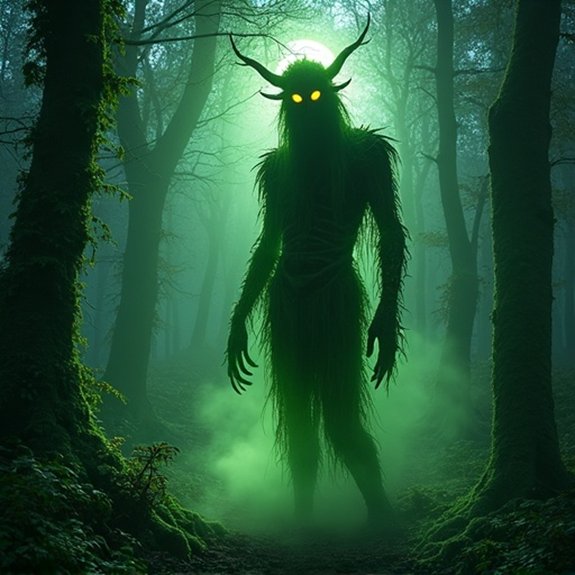The Legend of the Green Man
The Green Man‘s carved face peers from medieval cathedral walls across Europe, yet his origins stretch back over two millennia. He’s neither fully human nor entirely plant—his features merge seamlessly with oak leaves and vines. While Christian stoneworkers embedded him in sacred architecture, his roots sink deeper into pre-Christian soil. What compelled ancient artisans to blend man with nature, and why does this mysterious figure still captivate modern minds?
Introduction

Mystery surrounds the ancient figure known as the Green Man, whose leafy face has peered from cathedral walls, tavern signs, and forest shrines for over two thousand years. This enigmatic symbol appears across Europe, from medieval churches to Roman ruins, always depicting a man’s face formed from or sprouting vegetation. Leaves emerge from his mouth, nose, and eyes, while vines wrap around his features, creating a fusion of human and plant.
Scholars can’t agree on his origins or meaning. Some trace him to Celtic nature deities, others to Roman gods of wine and fertility. He’s survived Christianity’s spread, appearing in Gothic cathedrals alongside saints and angels. Today’s neo-pagans claim him as an ecological symbol, while historians debate whether he represents rebirth, the wild forest, or humanity’s connection to nature itself.
Medieval European Folklore Roots
Although the Green Man‘s earliest appearances predate Christianity, medieval Europe transformed him into a powerful folk symbol that bridged pagan traditions and Christian architecture. Stone masons carved his leafy visage into church corbels, misericords, and capitals throughout England, France, and Germany. He’d emerge from foliage, sprout vines from his mouth, or merge completely with oak leaves and acorns.
Medieval communities recognized him as Jack-in-the-Green during May Day celebrations, where he’d represent nature’s rebirth. Folkloric tales cast him as a forest guardian who’d test travelers’ hearts or punish those who harmed sacred groves. By the 14th century, he’d become so widespread that over 2,000 Green Man carvings decorated European churches, silently preserving pre-Christian nature worship within Christianity’s most sacred spaces.
Notable Cases or Sightings

Beyond stone carvings and folk festivals, witnesses have reported encounters with living Green Men throughout history. In 1968, Surrey resident Margaret Hodges claimed she’d seen a leafy figure emerge from Wychwood Forest at dusk. The being stood seven feet tall with bark-like skin and moss covering its shoulders.
Scotland’s Birnam Wood generated multiple sightings during the 1970s. Hikers described a humanoid creature with branches sprouting from its head, moving silently between ancient oaks. Local police documented three separate reports but found no physical evidence.
Most recently, in 2019, two campers in Germany’s Black Forest photographed what they believed was a Green Man. The blurry image shows a tall figure partially concealed by foliage, though skeptics attribute it to pareidolia.
Common Theories or Explanations
When scholars examine Green Man encounters, they’ve proposed several compelling explanations for these mysterious sightings. Cryptozoologists suggest witnesses might’ve spotted an undiscovered primate species adapted to forest environments. The creature’s reported green coloration could result from algae growth on fur or natural camouflage evolution.
Folklorists argue the Green Man represents archetypal nature deities found across cultures. They’ve traced connections to Celtic forest gods and medieval wild men legends. These universal symbols might manifest through collective unconscious experiences.
Skeptics offer mundane explanations. They’ve documented cases where witnesses mistook hunters in ghillie suits, moss-covered tree stumps, or shadows for mysterious beings. Sleep deprivation and pareidolia—seeing patterns where none exist—could trigger false sightings. Some researchers believe indigenous shamanic practices involving plant-based hallucinogens might’ve generated consistent Green Man visions throughout history.
Frequently Asked Questions
How Does the Green Man Legend Differ From Similar Nature Deities Worldwide?
The Green Man’s unique as he’s primarily architectural decoration in Christian churches, blending pagan symbolism with medieval Christianity. Unlike other nature deities who’re worshipped directly, he’s survived through stone carvings representing rebirth and vegetation cycles.
What Rituals or Festivals Specifically Honor the Green Man Today?
Modern pagans celebrate the Green Man during Beltane and May Day festivals. Jack-in-the-Green processions feature costumed performers in England. Neo-druids incorporate Green Man imagery in seasonal rituals. Some communities hold green man puppet parades annually.
Are There Any Archaeological Artifacts Definitively Linked to Green Man Worship?
No archaeological artifacts definitively prove Green Man worship existed. Medieval church carvings show foliate heads, but scholars can’t confirm they’re religious symbols. They might’ve been decorative elements rather than objects of veneration or ritual.
Which Modern Religions or Spiritual Movements Have Adopted Green Man Symbolism?
Neo-pagan traditions, particularly Wicca and Druidry,’ve embraced the Green Man as a nature deity. He’s also appeared in modern Celtic spirituality, eco-spiritual movements, and contemporary witchcraft practices celebrating seasonal cycles and environmental consciousness.
What Role Does the Green Man Play in Contemporary Environmental Activism?
Environmental activists’ve adopted the Green Man as a powerful symbol representing nature’s resilience and humanity’s connection to Earth. He’s featured in protests, eco-art, and campaigns promoting forest conservation and climate action across global movements.


